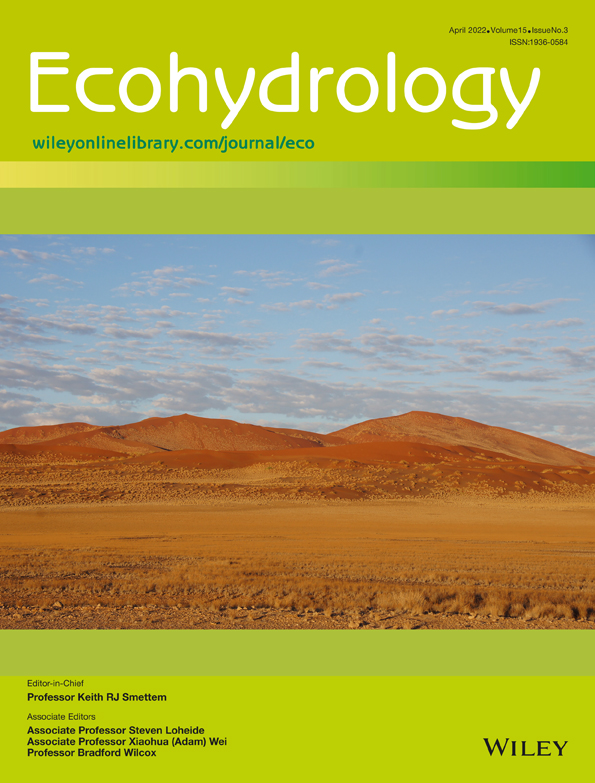How dynamic is the Brahmaputra? Understanding the process–form–vegetation interactions for hierarchies of energy dissipation
Abstract
The spatio-temporal heterogeneity in process–form–vegetation interactions has enabled the Brahmaputra river system to dissipate the fluvial energy at hierarchical scales. The present review article synthesizes the knowledge on braided rivers and an extensive review of the bio-morphological processes in the Brahmaputra River. In addition, field investigated datasets along with geo-spatial imageries and Google Earth Engine computed fluvial information are integrated to conceptualize and understand the complex underlying processes in the river. The review can be further used to propose rejuvenation frameworks and research directions concerning the implication of hierarchical energy dissipation potential in the Brahmaputra River.
1 INTRODUCTION
The braided rivers are equally beautiful and complex in nature. These systems comprise an unstable network of multiple channels, dynamic processes and are often observed in varied climatic regions and diverse physiographic settings (Surian et al., 2015). Furthermore, anthropogenic stresses develop transient morphological features and instream (or floodplain) geomorphic units in the braided rivers. In addition, braided streams are often synonymous with recurrent bar development, extreme bedload transport and high rates of bank erosion. To understand the process–form relationships of braided channel pattern, many researches have been conducted in the last couple of decades, focused on laboratory-scale experiments (Ashmore, 1988, 1991b; Hoey & Sutherland, 1991; Warburton, 1996), field-based studies (Ashworth et al., 1992; Davoren & Mosley, 1986; Goff & Ashmore, 1994; McLelland et al., 1996), numerical modelling (Brasington & Richards, 2007; Hardy, 2013; Javernick et al., 2016; Nicholas, 2013; Paola, 2001; Wright & Hargreaves, 2013) and integration of geo-spatial techniques (Belletti et al., 2014; Bertoldi et al., 2011; Fotherby, 2009; Javernick et al., 2014; Lallias-Tacon et al., 2014; Piegay et al., 2009; Pradhan et al., 2017, 2019; Surian, 1999; Wheaton et al., 2013; Williams et al., 2014).
This energy expenditure mechanism in the braided rivers shows the interdependence of the associated processes and channel form evolution (Pradhan, Chembolu, Dutta, & Bharti, 2021; Simon, 1992). In general, channel segmentation, bar erosion and migration are common morphological processes resulting in significant energy dissipation (Chembolu & Dutta, 2018; Dubey et al., 2020). It should also be noted that a considerable amount of energy in a braided river system is utilized through bedform changes and the braided belt width variability (Ashworth et al., 2000; Chembolu & Dutta, 2018). Simon (1992) investigated two different fluvial systems (coarse-grained and fine-grained sediment feedings) and observed that channel widening dominated the energy dissipation process in coarse-grained rivers. In contrast, fine-grained systems subjected to low energy are mostly dissipated through channel adjustment and deepening (Chorley, 1962). Few other studies have reported the bedform (ripples, mega-ripples, dunes and sand waves) has a significant influence on the water surface turbulence pattern (boils, vortices and macro-turbulent structures) and acts as a significant contributor to energy dissipation processes (Coleman, 1969). The flow resistance by vegetation colonization may dissipate a large portion of available fluvial energy in braided rivers (Bertoldi et al., 2011; Bertoldi, Zanoni, & Tubino, 2009; Gurnell & Petts, 2006; Pradhan, Padhee, Dutta, & Bharti, 2021; Wetzel, 2002). In low-energy vegetated channels, retention and stabilization of organic and mineral deposits create a supportive environment for establishing ‘tree islands’ (Wetzel, 2002). In addition, the vegetation may entrap, transport sediment and interact with high fluvial energy, which progressively drives the island growth (Bertoldi, Zanoni, & Tubino, 2009).
The Brahmaputra is a classic example of a large sand-bed braided river system (Coleman, 1969; Mosselman et al., 1995; Thorne et al., 1993), where the seasonal morphological changes are frequent due to large variability of the processes (flow and sediment transport) and geological factors (bed slope, nodal points, braided belt width and high erodible banks) (Chembolu & Dutta, 2018; Goswami, 1985; Karmaker & Dutta, 2011, 2013, 2015; Singh et al., 2004). Such extreme non-uniform nature of process–form interactions has enabled the river system to dissipate the fluvial energy at different scales. The previous studies on the Brahmaputra river have focused on flow–sediment variability (Fischer et al., 2017; Goswami, 1985; Karmaker & Dutta, 2015), morphological dynamics, and ecological responses through numerical modelling (Biswas et al., 2016; Karmaker & Dutta, 2016; Surabuddin Mondal et al., 2013), field investigations (Gul et al., 2018; Karmaker & Dutta, 2013), laboratory experiments (Chembolu & Dutta, 2018; Khan et al., 2021) and geo-spatial techniques (Akhtar et al., 2011; Dubey et al., 2014; Sarma, 2005). The synthesis of these literatures has established the energy expenditure can be targeted towards a single (or multiple) fluvial processes. However, in order to understand such a complex river system, the attention must be concentrated on the dominant fluvial processes which acquire a large portion of available energy. For example, the inexorable bank erosion combined with non-uniform flow–sediment transport has resulted in a mobile braided belt for the Brahmaputra. The migration of braided belt and associated geomorphic units (bars, islands, chutes, low-flow channel and flood channels) dissipate large chunk of fluvial energy. In addition, sandbar disorderness and eventual development confluence and bifurcation nodes signify the high energy expenditure potential of the Brahmaputra. The bio-geomorphic interactions, functionalities and feedback between braided geomorphic units and vegetated landforms are also crucial to address this dynamic river system. The succession of large instream islands (surface area close to 100 km2) significantly governs the processes and dissipates the energy as a natural barrier.
Therefore, the present review paper will attempt to synthesize the previous understandings of the braided Brahmaputra and formulate a conceptual basis for probable hierarchical (or overlapped) energy dissipation processes (Figure 1). Such conceptual understanding of the dominant processes (braided belt mobility, bar disorderness and instream vegetated landforms dynamics) in the highly braided rivers like the Brahmaputra will develop a foundation for future research. Therefore, each section is sub-divided into the synthesis of previous literature concerning braided rivers and the Brahmaputra, research gaps, and integration of fluvial and geo-spatial datasets. In addition, historical data-driven analysis integrating satellite products and field investigations are included in each section which will examine the energy dissipation processes in the river system. Finally, this study will attempt to facilitate an ecosystem-based approach instead of reach-scale studies for effective management of this large braided river system.
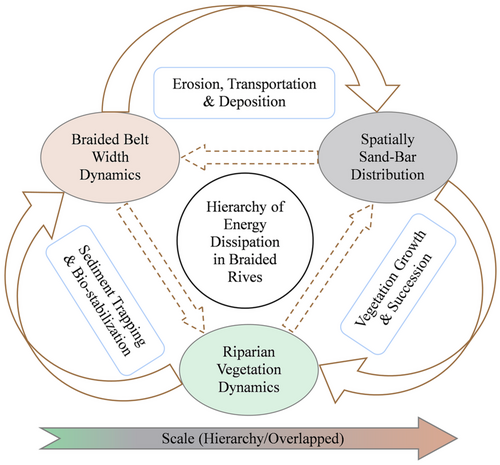
2 STUDY AREA
The present analysis is focused to synthesize literatures pertaining to process–form–vegetation interactions for a highly braided reach of the Brahmaputra. The study reach selected here consists of three nodal locations (Tezpur, Guwahati and Jogighopa) having the narrowest width (Figure 2). The reach is about 240 km in length and possesses a wide range of morphological activities. This river has flow variability in between 4420 and 51,516 m3/s (Singh et al., 2004), mean annual suspended sediment load close to 400 million tons (Sarma, 2005), average bed slope in the order of 0.0001 and a braided belt width of 1.2 to 18 km (Goswami, 1985).
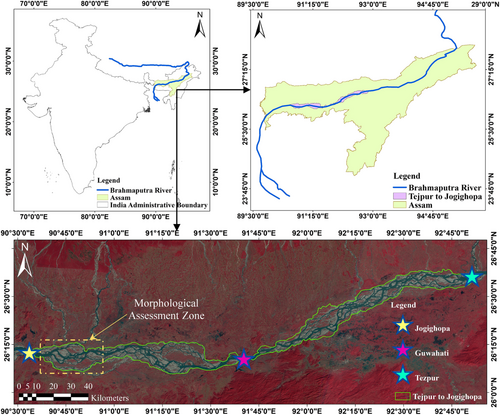
In the Brahmaputra, instream, and floodplain geomorphic units such as sand bars, low-flow channels, chutes, cut-offs, and vegetated landforms are dynamic in nature and display a hierarchy of energy dissipation potentials. The river is also prone to large-scale bank erosion along composite cohesive banks and supplies abundant sediment load to the morphologically active channels. The bed material composition is fine sand and silt ( : 0.16 to 0.21 mm), which makes it extremely sensitive to the changes in fluvial process variables (Karmaker & Dutta, 2011; Sarma, 2005). The shifting of river channels is also common throughout the braided belt resulting in flow separation, formation of mid-channel bars and further development of different degrees of braiding (Richardson & Thorne, 2001). A conceptual illustration of different stages of braiding and corresponding vegetated landforms is shown in Figure 3. The channel behaves as a single channel at section A-A (nodal points), a moderately braided channel at section B-B, and a highly braided channel at section C-C.
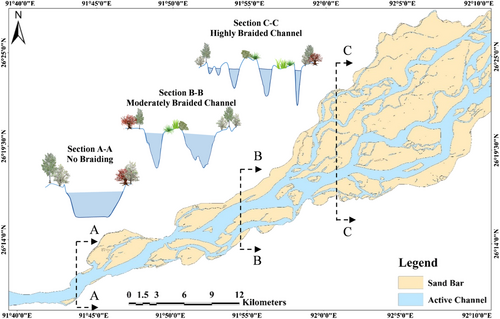
3 ENERGY DISSIPATION PROCESSES IN A HIGHLY BRAIDED RIVER SYSTEM
3.1 Braided belt width mobility and the implication of composite cohesive banks
In a highly braided river system, lateral migration and bank erosion are related to the complex flow–sediment dynamics and associated geomorphological activities in terms of bar disorderness, thalweg migration and intense water level variation. For rivers such as the Brahmaputra, these braided river dynamics are scaled up by many folds due to the aggravated sediment waves (Fischer et al., 2017; Karmaker & Dutta, 2010), macroturbulence structures (Sharma & Akhtar, 2017), variability in the vegetated landforms (Chembolu & Dutta, 2020), cohesive banks (Karmaker & Dutta, 2015) and nodal points (Chembolu & Dutta, 2018). Generally, in cohesive banks, erosion occurs after the breaking of electromechanical forces between the aggregates. Both shallow water and extreme flood events can be responsible for the shuddering of cohesive banks, leading to accelerated bank erosion. Interestingly, this cohesive bank erosion and timing of peak discharges are weakly related in the Brahmaputra (Sarker et al., 2014). This may establish that the bank erosion process in the Brahmaputra may not depend only upon the high energy expenditure potential of extreme events, rather gradual soil saturation by periodic low-moderate floods, deflection angle, longitudinal slope and local bed material size can affect the extensive bank erosion (Karmaker & Dutta, 2015; Mosselman, 2006; Surian et al., 2009).
The synthesis of literatures pertinent to fluvial bank erosion suggests a varying annual rate across the world's large rivers. For example, rivers like the Sacramento River (US), the Nile (Africa), the Tagliamento River (Italy) and the Yangtze (China) have an annual erosion rate up to 10–50 m/year (Ayman & Ahmed, 2009; Deng et al., 2019; Larsen et al., 2006; Surian et al., 2009). On the other hand, the annual bank erosion rate in the Brahmaputra is significantly higher in comparison to these notable dynamic river reaches. In fact, high bank erosion of 100 m/year (Mosselman, 2006; Mount et al., 2013) along with local scale erosion up to 1–2 km/year is even observed in these river reaches (Sarker et al., 2014). The spatio-temporal variability in the bank erosion process has further developed a dynamic braided belt width in the Brahmaputra River. The old maps of the 1800s in the Bangladesh region suggest the Brahmaputra may have followed a meandering channel pattern (Thorne et al., 1993). In the later period, with the increase of both fluvial and anthropogenic disturbances, the river has significantly altered the process–form relationships. The meandering planform is eventually replaced by a considerably wider braided channel pattern accompanied by a significant rate of bank line retreat. As suggested by Lawler (1995), one or combination of the processes such as sub-aerial erosion, fluvial entrainment and mass failure caused by weakened bank materials is majorly responsible for river bank erosion. It has been observed that, in the Brahmaputra river, the water level falls rapidly during the recession limb and the pressure against the wall decreases, which resulted in the backwater movement from the bank and causes subaqueous failure by lateral flowage of sand and silt to the river (Karmaker & Dutta, 2011). Furthermore, the river experiences frequent channel migration, which enables the migrating channel intersects the bank line at some locations. Eventually, that uplifts the water level in the bank, saturates the sand and silt, and in the subsequent falling limb, saturated sediments are liquified by forming well-defined shear planes. These processes contribute to the braided belt dynamics of the Brahmaputra River. The mean width of the Brahmaputra River in Assam valley is about 5949 m during the year 1912–1928 (Sarma & Acharjee, 2018). The mean width has increased up to 7455 m due to intense bed aggradation after the great Assam earthquake of 1950 (Goswami, 1985; Takagi et al., 2007). The braided belt width has rapidly increased up to 1980–90s and gradually stabilized in the next two decades (Takagi et al., 2007) (reproduced from Karmaker et al., 2017 and integrating recent satellite imageries). In the 2000s, the mean braided belt width of Brahmaputra River is observed close to 9012 m, with distinct nodal locations and multichannel segments. Figure 4a shows spatio-temporal variability of braided belt width for the middle stretch of the Brahmaputra (approximately 240 km). The percentage change in braided belt width variation is higher in the 1970s as compared to the 1990s, 2000s and 2010s. This further indicates the reach is approaching a dynamic stable state after the 1970s. However, in recent years, the braided belt width variability is relatively higher, resulting in a dynamic, unstable (or transient) state. The downstream stretch from Guwahati is morphologically more dynamic in terms of braided belt width variability, which is more than 80 percentages (in the early 1990s) and 30 to 60 percentages (in the late 2010s), respectively.
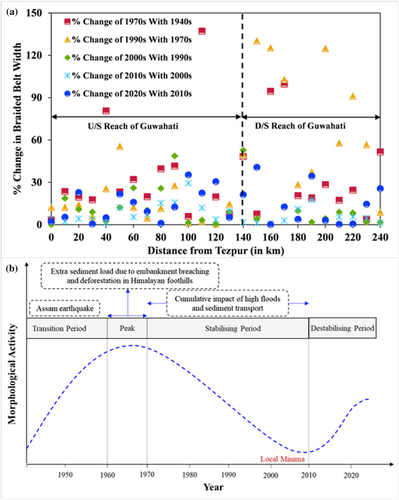
The temporal dynamics in braided belt width (channel instability) can be attributed to numerous hydrological (floods and sediment wave), topographical (nodal points and local bed slope) and geological factors (bank erodibility, earthquakes and landslides). The Brahmaputra River has experienced a sequence of geomorphological stages (1950 to 2020) with an interval of 5 to 10 years (Takagi et al., 2007). Furthermore, during the monsoon season, this river generates a considerable quantity of energy in the system due to a sequence of large flood waves. The morphological parameters mainly affected by this huge incoming energy are thalweg shifting (sinuosity), bank erosion, deposition, alteration in bed slope, channel widening and so on. According to previous studies, flood stream power arguably regulates the morphodynamics of the braided rivers (Akhtar et al., 2011; Bizzi & Lerner, 2012; Magilligan et al., 2015). However, in case of Brahmaputra River, the stream power has no direct influence on the braided belt variation (Karmaker et al., 2017). The fluvial energy is dissipated within the system by forming a series of braided loops, resulting in the generation of new secondary/tertiary channels as well as the blockage of the existing defined water ways (Chembolu & Dutta, 2016). This process leads to the increase in planform disorderness of the system. Additionally, the energy associated with the rising peak flood has a significant erosion potential, which can be capable of reshaping the shallower channel to deeper, washing out smaller unstable (mobile) bars and triggering acute bank erosion. Part of the fluvial energy is also stored/absorbed within the system eventually before it initiates a new planform change (Charlton, 2007). A conceptualization of the channel instability in the Brahmaputra River basin integrating the studies of Goswami (1985), Takagi et al. (2007), Karmaker et al. (2017) and Chembolu and Dutta (2018) is shown in Figure 4b. After the 1950s, the extreme earthquake and series of landslides stimulated high sediment loads completely dominated the morphological processes. This resulted in an instability of the braided belt width and initiation of (de)stabilizing waves. The propagation of these waves was unclear in the succeeding decades, and the river was in a quasi-dynamic equilibrium state. But from the 1980s onward, the river was morphologically active and showed high fluctuations in the braided belt width with complex landform distributions. The sandbar disorderness study has established a stabilizing state in the first decade of the 2000s. However, after the 2010s, the river has again increased the channel instability in terms of bar disorderness as observed from the recent satellite imageries and field observations. This knowledge indicates a higher magnitude of energy is expended during the braided belt adjustments, which cannot be overlooked and needs to be addressed in process-based understanding.
3.2 Channel bar dynamics and formation of large-scale confluence–bifurcation
Bars are the key geomorphic unit and the fundamental building block of a braided river system. Several braiding formation processes are formulated, entailing the bar development as a single unit or assemblages. In most cases, braiding is related to the conversion of the alternate bar to a multiple row bar or mid-channel bar via cut-offs formation. In sandy braided rivers, the lobate bars are known as ‘unit bars’ (Ashmore, 1991a; Smith, 1974), which have individual downstream restrictions with avalanche faces (Bridge, 1993). However, with the progression of time, these unit bars are gradually deposited, sculpted, or dissected and developed into braid or compound bar in the braided rivers (Bridge, 2003; Bridge & Lunt, 2006). Depending upon the mobility of bars, forced bar (less migration rate) and free bar (high migration rate) are taxonomized for braided river systems (Bridge, 2003).
The growth and dynamics of confluence–bifurcation are also key features of braided channel networks (Ashmore, 2013; Leopold & Wolman, 1957; Tubino & Bertoldi, 2007). A number of studies have focused on understanding the formation and evolution of channel bifurcations through laboratory experiments (Ashmore, 1991b; Bertoldi & Tubino, 2007; Federici & Paola, 2003), field observations (Ferguson et al., 1992; Richardson & Thorne, 2001; Zolezzi et al., 2006) and numerical modelling (Bolla Pittaluga et al., 2003; Jagers, 2003). Ashmore (1991a) has reported four dominant mechanisms responsible for bifurcation commencement in braided rivers, such as (i) chute cut-off, (ii) initiation of the central bar, (iii) transverse bar alteration and (iv) multiple bar braiding. Bifurcations may also be symmetric or asymmetric depending upon the division of flow sediment an individual branch. In particular, the sand-bed rivers (relative to gravel-bed channels) are more prone to symmetrical bifurcations due to the increased Shield's stress (Best et al., 2007). It should also be noted that the flow–sediment partitioning of the active channel relies on the bifurcation dynamics (Bolla Pittaluga et al., 2001; Bristow & Best, 1993), and this activity may switch between the individual branch depending upon the upstream bar migration rate. The confluence node points serve as an interface zone for upstream lateral erosion and downstream deposition. Similar to the bifurcation nodes, confluences may also have symmetric and unsymmetric formations. To understand the dynamic confluence morphology, precise field observations of the flow structure near the zone, shear stress distribution and sediment discharge pattern are necessary (Ashmore et al., 1992; Ashworth et al., 1992; Davoren & Mosley, 1986; Ferguson et al., 1992). Numerous factors also influence the morphology of confluences, including total and relative discharge at confluent anabranches, bedload yield to the confluence, boundary shear stress, particle size distribution, angle of confluence and several anabranches (Ashmore, 1993; Mosley, 1976). In addition, the confluence angle and discharge of the anabranches control the size and depth of scouring (Ashmore, 1993, 2013). In the case of high angle confluences and equivalent anabranch discharge, scour depth is more expensive. This scour depth is marginally less for considerable variation in anabranch discharges, irrespective of confluence angle (Ashmore & Gardner, 2008; Ashmore & Parker, 1983; Best, 1986; Mosley, 1976).
In the Brahmaputra River, the formation of bars along with confluence–bifurcation nodes can be attributed to a number of dominant hydrogeomorphological factors. Due to its complicated flow–sediment discharge characteristics, the Brahmaputra is one of the few braided river systems in the world that exhibits dynamic morphological behaviour (Dubey et al., 2021; Goswami, 1985; Karmaker & Dutta, 2011, 2013; Pradhan, Dutta, & Bharti, 2021). A very limited number of studies have been conducted to understand the sandbar dynamics (growth/adjustment/propagation) in this river system. The formation of braided patterns in the river is mainly determined by the formation/growth of sand bars. In addition, the sandbar dynamics are linked to the series of erosion–deposition processes in the river system. During high-flooding episodes, the incoming energy to the river system eventually regulates the underlying sandbar dynamics. During this period, morphological processes such as bar displacement and river channel fragmentation become prominent, which disperse a significant amount of energy. Furthermore, it governs the grain size distribution of the sediment material and its conveyance to a bar head, which influences the size and stability criteria of a bar. Depending upon the hydraulic regime and reach parameters, the river bed configuration (bed roughness) also provides varied resistance to the flow, which also dissipates a substantial amount of energy (Dubey et al., 2020; Pradhan, Chembolu, Bharti, & Dutta, 2021). According to Dubey et al. (2020), the channel has reduced roughness during the monsoon season compared to the non-monsoon season, which results in a steady river morphology in the course of monsoon period. During high floods, the flow energy increases and results in the erosion of mobile bars, which then gradually falls after the flood recedes, and irregular deposition of sediment material is observed (Chembolu & Dutta, 2018). At first, the river may encounter up to nine flood events of varying durations and sediment transport in a year (Karmaker & Dutta, 2010) and develop geomorphic units with multiple inundation surfaces. In addition, the substantial reduction of bed elevation at the India–China border (a drop of around 4800 m within a length of about 1700 km) and change in average bed slope from 2.8 to 0.1 m/km in the Assam valley have produced a large braided channel of high energy dissipation potential. The nodal points also facilitate the channel to scour at the local scale and eventually deposit the excess sediment load across the widened braided belt sections. Table 1 shows the development of channel bars (based on mobility) and probable bifurcation–confluence statistics along two braided reaches (Tezpur to Guwahati and Guwahati to Jogighopa) of the Brahmaputra. The morphometric analysis is performed focusing on the sandbar dynamics. The informations in Table 1 were obtained by analysing the 20 years (2000 to 2019) of satellite data using Google Earth Engine (GEE) platform. The data extracted from GEE were then processed in ArcGIS environment to determine statistics related to sandbar area and bifurcation/confluence configurations. The modified normalized difference water index (MNDWI) (Han-Qiu, 2005; Xu, 2006, 2007) was used with a threshold value (MNDWI < 0) to identify the sand bars. Further, the sand bars were categorized into seven different classes based on their surface area to understand the influence of bar dynamics on the morphological behaviour. Baki and Gan (2012) reported, the large bars are generally referred to as forced bars with low mobility (or immobile) rates in terms of shape, size and location, whereas small bars are referred to as free bars with high mobility rates that further play a key role in morphological changes. In the case of the Brahmaputra River, huge immobile bars form the large islands, whereas smaller mobile bars appear to have transient characteristics. It is interesting to note that bar surface area varies from 0.0006 to more than 100 km2, and clusters of mobile, moderate–low mobile and immobile bars have formed as instream geomorphic units. Most of the bars can be classified as mid-channel longitudinal and diagonal bars, and occasionally side-channel and lateral bars are developed close to the cohesive high banks. Furthermore, more than 800 channel bars (temporal average of 20 years) have produced a complex braided planform of varying confluence–bifurcation geometries. The mobile bars have mostly asymmetric bifurcation (or confluence) configurations, whereas the large bars (surface area > 1 km2) are symmetric in nature. Similarly, the configuration angle is less (close to 30–45°) for mobile bars, which gradually increases for static mid-channel islands.
| Bar description (↓)/Braiding process description (→) | Bar frequency statistics | Bifurcation/Confluence statistics | |||||||||
|---|---|---|---|---|---|---|---|---|---|---|---|
| Nature of bar | Bar class (based on surface area) | Area (in km2) | Tezpur to Guwahati | Guwahati to Jogighopa | |||||||
| Max | Min | Mean | Max | Min | Mean | Average angle bifurcation (in degree) | Average angle confluence (in degree) | Configuration details (symmetry/asymmetry) | |||
| Highly mobile | Class 1 | >0.0006 and ≤0.001 | 348 | 113 | 188 | 294 | 123 | 182 | 30 | 45 | Mostly asymmetry |
| Class 2 | >0.001 and ≤0.01 | 572 | 218 | 351 | 659 | 238 | 414 | 45 | 30 | Mostly asymmetry | |
| Moderately mobile | Class 3 | >0.01 and ≤0.1 | 289 | 112 | 152 | 211 | 113 | 165 | 45 | 45 | Mostly asymmetry |
| Class 4 | >0.1 and ≤1 | 126 | 65 | 93 | 131 | 83 | 103 | 60 | 45 | Mostly asymmetry | |
| Low mobile | Class 5 | >1 and ≤10 | 74 | 51 | 63 | 72 | 48 | 60 | 60 | 60 | Mostly symmetry |
| Class 6 | >10 and ≤100 | 23 | 14 | 19 | 31 | 9 | 16 | 90 | 60 | Mostly symmetry | |
| Immobile | Class 7 | >100 | 0 | 0 | 0 | 2 | 0 | 1 | 120 | 90 | Mostly symmetry |
Figure 5 illustrates in-channel geomorphic units of varying surface water occurrence (SWO) in the Brahmaputra. The active low-flow channel flows through numerous confluences and bifurcations and develops transient morphological features across the variable braided belt (Figure 5a). The low-flow channels have SWO varying between 80% and100%, signalling permanent water availability. However, the thalweg is not defined at few locations, which provides notable lateral freedom to the channel and attacks the fixed bars. The fixed bars are mostly emerged (SWO below 20%) and periodically subjected to sculpting during the high flows. The chutes are developed on the surface resulting in short-circuiting of flood channels. The bar assemblages are highly dynamic in nature resulting in a planform disorderness at spatio-temporal scales. For example, in the pre-monsoon season, the Brahmaputra is dominated by medium to large-sized sand bars. However, in the post-monsoon season, the same bars are dissected to smaller mobile and transient bars (SWO of 45% to 60%) and increases the entropy of the fluvial system. These smaller sized bars are mostly submerged during floods and subjected to migration in the highly sediment-charged environment. Figure 5b signals the presence of probable channel-in-channel physiography of the Brahmaputra River. The low-flow channel (mega-channel) has maximum width up to 4–5 km and carries a significant portion of the flow–sediment discharge. In addition, these zones can be regarded as the active braided belt segment with a combination of dominant confluences and bifurcations. The fixed bars and floodplains can be considered as inactive braided belt zone, which are mostly active during high flows and extreme events. Therefore, a comprehensive evaluation of the bar dynamics along the active morphological reach is necessary and can aid in quantifying the energy utilization in braided physiographic settings.
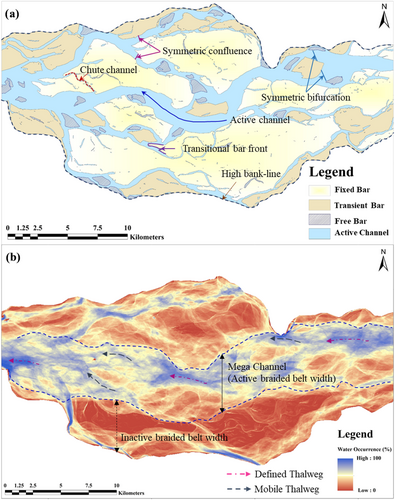
3.3 Process–morphodynamics–vegetation interactions at landform scale
Instream vegetation is a vital component of fluvial systems and has a significant impact on river rejuvenation schemes by improving the physical features and ecological conditions (Bennett & Simon, 2004; Gurbisz et al., 2016, 2017; Gurnell, 2014; Kondolf et al., 2013; Lera et al., 2019; Nandi et al., 2021; Nepf & Ghisalberti, 2008; Vargas-Luna et al., 2018; Wilson et al., 2003). Similarly, riparian vegetation has a significant impact on river morphodynamics since it interacts with the flow–sediment discharge at different spatio-temporal scales, triggering a series of intricate feedbacks and linkages (Camporeale et al., 2013, 2019; Gurnell, 2014; Gurnell & Petts, 2002; Henriques et al., 2021). In addition, aquatic vegetation considerably adjusts the flow and turbulent structure and affect the riverine habitat (Bornette & Puijalon, 2011; Boruah et al., 2008), water quality (Dosskey et al., 2010), pollutant-nutrient distributions (Perucca et al., 2009; Shucksmith et al., 2010) and sediment transport process (Baptist, 2003; Bertoldi, Gurnell, et al., 2009; Gonzalez et al., 2019; Jordanova & James, 2003; Kothyari et al., 2009; López & García, 1998). Vegetation is also related to the morphodynamics by governing the braiding intensity (Belletti et al., 2015; Gran & Paola, 2001; Kui et al., 2017; Tal & Paola, 2007), promoting bar accretion and bank stabilization (Bertoldi et al., 2011; Gurnell, 2014). A number of laboratory-scale studies (Coulthard, 2005; Gran & Paola, 2001; Tal & Paola, 2010) have been performed to understand the vegetation interactions with braided river morphodynamics integrating non-natural rigid (Bennett et al., 2002; King et al., 2012; Liu et al., 2008) and flexible cylindrical stem (Chembolu et al., 2019; Chen et al., 2011; Velasco et al., 2008) submerged (or emergent) vegetation.
In the braided rivers, instream/riparian vegetations and aquatic plants represent the fluvial environment, climatic conditions and local geological factors. The vegetation can either actively or passively contribute to the morphological activity of rivers (Camporeale et al., 2013, 2019). The passive role represents the impact of vegetation on roughness, hydraulic resistance and erosion/deposition characteristics which have alike morphological and mechanical properties. On the other hand, the active role refers to the biotic process linked with plant community colonization and life cycle, which regulates the morphodynamics of the river. Furthermore, certain species have the ability to colonize exposed or flooded alluvial sediments and create pioneer landforms (Bertoldi & Gurnell, 2020). Thus, individual species or patches in a braided fluvial system can operate as an ecosystem concocts in a variety of environmental conditions. Through a spatio-temporal series of interaction between the vegetation and geomorphic processes, the associated energy in the braided reach can be dissipated by various means. The growing vegetation root networks has been demonstrated to stabilize sediment deposits by diverting the flow and strengthen the soil (Bywater-Reyes et al., 2018; Polvi et al., 2014), which further reduce the flow velocity (Vargas-Luna et al., 2015) and increase the deposition of sediment minerals (Cotton et al., 2006; Meier et al., 2013; Nepf, 2012). This also leads to the formation of pioneer planforms (bars/islands) which affects the local physical conditions and accelerates eventual colonization of different species (Gurnell, 2014). Additionally, the pioneer islands actively contribute to the hydrogeomorphological processes, giving rise to the establishment of a larger island with a broader space during the lean seasons and sagregated during the extreme flood events. In this way, vegetation can operate as a ‘ecosystem engineer’, aiding its development and establishment (Gurnell, 2014; Gurnell & Petts, 2006), which is the primary stairway towards the accretion of river banks, the formation of river islands, and, as a result, changes in river characteristics and planforms (Bertoldi et al., 2014; Wintenberger et al., 2015). There are limited studies available for understanding the interactions between active channels and instream/flood plain green corridors in the braided rivers. Further, for a highly braided river like the Brahmaputra, these bio-morphological processes become extremely complex and unpredictable due to the variable growth cycle of vegetation species and their controlling factors. The Brahmaputra has varied instream or floodplain vegetated landforms that affect the bio-morphological processes (Figure 6). During the high flows and extreme events, these vegetated structures offer resistance to the incoming flow and further help in stabilizing the submerged landforms.
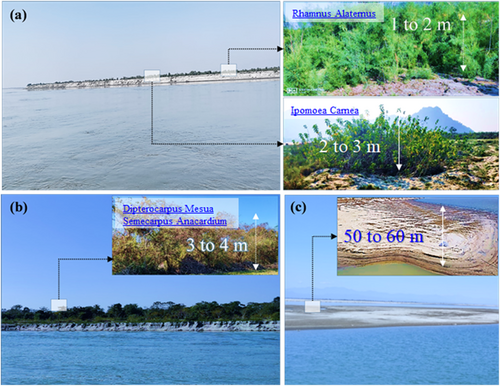
To establish a framework for a more comprehensive investigation of island distribution, its character and dynamics, a precise understanding of an island in terms of size, form and structure is required. It is important to carry out this objective as size of island provides significant information on its stability-structure and can be used as a parameter for identifying islands from maps and aerial imageries (Gurnell et al., 2000). The braided rivers can be classified based on the ratio of island area to gravel (sand) area (IBR) as bar-braided (no island present), bar-braided with occasional islands (<0.25), island-braided (in between 0.25 to 0.5) and heavily island-braided (>0.5) (Gurnell et al., 2000). This classification is applied to the Brahmaputra by dividing the entire study reach into eight zones with lengths varying between 19 and 55 km (Figure 7a). The zones are defined by local nodals identified using the high-resolution global surface water maps (Pekel et al., 2016). The vegetation cover information was also mapped for the whole stretch using the normalized differenced vegetation index (NDVI) (Figure 7b). The GEE platform was used to obtain NDVI images for the selected study reach, and the vegetated pixels were identified using a threshold value (NDVI > 0.2) (Bertoldi et al., 2011). In addition, the vegetated area was calculated, and the previously determined sand bar area (Section 3.2) is included in the IBR value computation. Zones 1, 5, and 7 confirm to occasional islands category; Zones 2 and 3 fall under island-braided; and Zones 4, 6, and 8 represent heavily island-braided segments (Figure 7c). Interestingly, zone without vegetation cover on the bar surface is not present in the entire study area. The heavily island-braided zones (4, 6 and 8) (IBR of 0.62, 0.76 and 0.59, respectively) have higher braided belt variability (average of 10 to 11 km). These reaches accommodate larger bars that are stable in nature and provide a favourable condition for vegetation growth and succession. On the other hand, Zones 2 and 3 (IBR of 0.25, 0.76 and 0.40) featuring medium and small-size bars have a low island-to-bar ratio due to less growth of vegetation. However, Zones 1, 5 and 7 (IBR of 0.21, 0.20 and 0.22, respectively) have the lower island-to-bar ratio attributed to the presence of smaller size bars that are mobile in nature and possess the least vegetation cover.
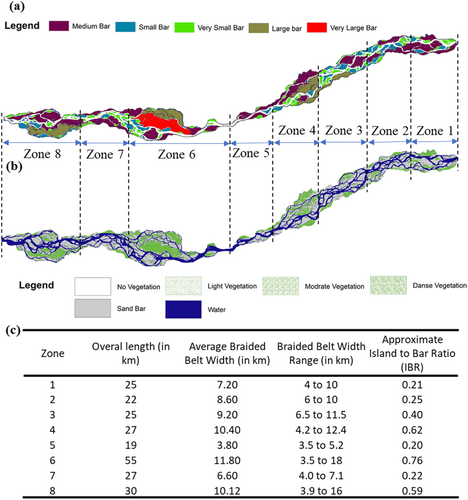
In the Brahmaputra River, the island formation process begins with the deposition of fine sediments around vegetated landforms, and further trapping of sediments provides stability characteristics (Charlton, 2007; Latrubesse, 2015; Orton & Reading, 1993; Pradhan et al., 2020; Rogers & Goodbred, 2014). This concept encompasses varieties of interdependent processes occurring on instream and riparian vegetation, such as seed dispersal, recruitment, growth and mortality. The spatial scale hydromorphological cascade processes and the landforms appear according to vegetation growth-succession, which are further responsible for the bio-morphological stabilization, river rejuvenation and restoration (Figure 8). In the Brahmaputra, a multiscale approach can be considered (reach to catchment or catchment to reach scale) for instream or riparian vegetation characterization and succession. In the first approach, recruiting and establishing pioneer species on bare alluvial bars can be facilitated by water availability, flood disturbance and geomorphic unit recreation at the local scale (i.e., location-specific shear stress, time and frequency of flood) (González et al., 2018; Johnson & Jones, 2000; Karrenberg et al., 2002). In the second approach, scale-dependent dominancy of climatic conditions, geographic formation and progressively flow regime, valley contexts and local lateral flood plains control channel dynamics and geomorphic unit development and maintenance (Fryirs & Brierley, 2012). River corridor vegetation serves as a substantial energy dissipation component and has the ability to operate as a morphogenetic agent by exerting a large influence on the processes of erosion, transportation and deposition of sediment. Thus, it is decisive to acknowledge the process–form–interaction of instream-floodplain vegetation, which contributes to the stabilization of fluvial landforms and control the braided morphology.
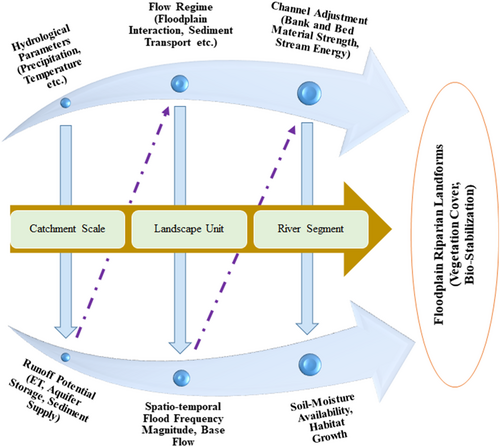
4 SUMMARY AND FUTURE SCOPE
The riverine problems of the Brahmaputra are significant concerns for river managers, hydrologists and geomorphologists. For example, the bank erosion and braided belt width variability not only affect the morphological processes but also impact the individual, community, habitats and economy (Mosselman, 2006; Sarker et al., 2014). According to Piégay et al. (2006), there is not such a unique solution for managing the braided rivers, and managers should take care of in-effect or apparent ecological values along with the evolutionary course of the river, besides human safety and protection of economic interests. Hence, estimating lateral mobility, bar disorderness and vegetation–landform interactions are essential for a dynamic river like the Brahmaputra, and the undisturbed ‘room for the river’ concept should be promoted among the community and stakeholders level.
- A major portion of fluvial energy is getting dissipated by altering the braided belt width in the Brahmaputra River. The river passes through multiple geomorphic stages of 5- to10-year duration, and (de)stabilizing agents like flow–sediment variability, geological factors (nodal, landslides and earthquakes) and anthropogenic stresses (mining and deforestation) are among the contributing factors.
- The next energy expenditure potential can be referred to as formation of bar assemblage along with confluence–bifurcation nodes. The surface water dynamic analysis also signals the presence of a mega-channel and channel-in-channel physiography within the high cohesive banks.
- The Brahmaputra has varied instream or floodplain vegetated landforms that affect the bio-morphological processes. The flow resistance offered by vegetated landforms dissipates a share of fluvial energy and further helps to stabilize the dynamic geomorphic units at the landform scale.
These understandings can be helpful for improving the morphological stability of this dynamic river system, but still, several research issues will persist due to the large-scale spatio-temporal heterogeneity in the governing processes. In addition, long-term goals (instead of short-term objectives) should be prioritized for unravelling the complex interrelationships between cohesive and destructive forces that regulate succession and restoration dynamics within the fluvial corridor. To conceptualize eco-geomorphic river typology, studies must develop dynamic prospective methods that incorporate the functional behaviour of vegetation–landform corridors and associated fluvial processes. The Brahmaputra alluvium is also composed of depositional elements and is affected by both auto-cyclic (hydrograph type, local sediment transport) and allocyclic (aggradation rate, active tectonics) controls. For designing a proper methodology to characterize the extensive scale of the braided river system, several parameters like sediment transport structure (erosion–deposition architecture) and scale dependency of geometrical characteristics (planform changes) should be considered. Similarly, the unavailability of real-world river datasets and ungauged tributaries create challenges during the formulation of numerical models and physical scale experiments. Therefore, future researches should target to comprehend the energy dissipation processes in the complex process–form environment and integrate the findings to provide a nature-based solution to tame the Brahmaputra.
ACKNOWLEDGEMENT
The authors acknowledge all earlier contributions on this subject. Efforts are taken to cite most of the relevant research findings in this review article.
Open Research
DATA AVAILABILITY STATEMENT
Research data are not shared.



